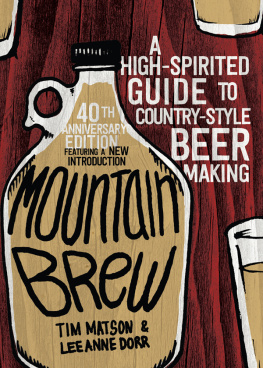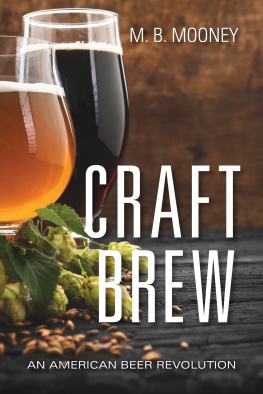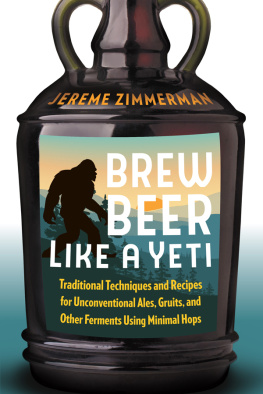

For all the drunks who didnt make it home
Contents
Please bookmark your page before following any links.
Foreword by Adam Krakowski, coauthor of
Vermont Beer
All it takes is a spark, an idea that becomes more than the sum of its parts. When Mountain Brew debuted, it was a perfect specimen of Vermonts future attitude towards beer. Only Tim Matson and Lee Anne Dorr never knew it. Tim and Lee Anne wanted better beer than what they could buy. In a time where brewing equipment was scarce, homebrewing illegal, and proper ingredients difficult to find, they embraced the situation. They built what was needed, grew their ingredients, and brewed it. So great was the journey, they published their adventures and sold it out of their car to anyone that wanted to buy it. They were one of the sparks that reignited Vermonts brewing industry.
Looking at Vermonts history in brewing, one thing in particular stands out: the loss of brewing knowledge. With Vermont entering a self-imposed prohibition on beer and spirits in 1853, we effectively suffocated a brewing heritage that was just starting to get off the ground. One single brewer carried on his trade in Burlington until the 1880s. When he too gave up, so began a long brewing void in Vermont. While Vermonters were crafty in circumventing the law, state and federal prohibition stopped the legal commercial production of beer in the state for nearly a century.
Along with this noble failure of an experiment, we lost the knowledge of brewing within the state. All that was left in the 1970s beer world were mainly the remnants of World War IIAmerican adjunct lagers and more flavorful imported beers. Aside from Fritz Maytags endeavors at Anchor Brewing on the West Coast, the American brewing scene was limited to fewer than 100 breweries in 1975, most producing American lagers. None of those were in Vermont. With no real handbook on how to brew beer available, Tim and Lee Anne took the first step toward rebuilding our collective knowledge. Charlie Papazians monumental work, Joy of Home Brewing , would come out a decade later, blowing off the door to the world of homebrewing that Mountain Brew had cracked open.
Rarely does someone write a book with the mindset of starting a wider movement. Mountain Brew was written as a guide on how to brew beer with a by any means necessary attitude for people just like Tim and Lee Anne. The first modern homebrewing book written since the repeal of Prohibition, it was published at a time when it was still illegal to produce homebrewed beverages in America. While the world of brewing has moved forward and the recipes featured here may not be up to the palates of brewers today, this work gives the history of where we (re)started. To understand these roots and how we evolved in the world of brewing is to take a fascinating look at technology, attitude, and development. Looking back at the forty years since Mountain Brew was first published, Vermont has become arguably one of the top regions of brewing in the country and even the world. It is time to grab a chair, pour a beer, and learn about an important moment in beer history.
Adam Krakowski |
Montpelier, VT |
2015 |
This being the 40th anniversary of the publication of a long-lost beer making book (one that many consider one of the founding documents of the homebrew and craft beer movement) and having been tasked with concocting a tasty introduction to said book, I invite readers and brew lovers to travel back with me to the dark ages of American beerthe 1970s. Even in those macro-brewing days, a select few of us were toiling away on our own bewitching ales and lagers, produced under the most adverse and twisted of circumstances. Once quaffed, those beers led to the recipes and literary meanderings of the very book you now hold, scan, view, or whatever now passes for reading.
To share in the shenanigans of this time warp firsthand and generate your own original tasting notes, I recommend you skip this behind the scenes commentary and go directly to the original book, which begins . There, the flavor profile of the Seventies bursts forth like a juicy Vermont IPA (even though there was no such thing back then). Then, you can return here to see how these untutored fermentations could have erupted in the mountain landscape that was Once Upon a Time Vermont. Or if you prefer, quaff this introduction first. Either way, read responsibly.
Once Upon a Time in a Nova Far Away
Vermont in the Seventies was a proving ground for the early homebrew and craft beer revival. Or rather, re-revival. After all, America had over 1,000 regional breweries during the nineteenth and early twentieth century. But a combination of Darwinian economics and the temperance-inspired Prohibition left the country with a small fraction of those breweries after the 21st Amendment.
The survivors of Prohibition were dominated by big conglomerates like Budweiser, Schlitz, and Coors. These resurrected beers had been reformulated to cut production costs and dilute the taste to appeal to a broader market. As William Knoedelseder notes in his book Bitter Brew , drinkers of traditional beer (Europeans mostly) took a pretty harsh view of Budweiser, seeing it as part of the Americanization of the world. For example, The Economist even went so far as to call Bud a glass of water wasted. The rationale for making bland beer is simple: If you can produce a product with general appeal, amenable to mass manufacture and predictable distribution across the country, you can make a lot of dough. Adding insult to injury, as the rollback of Prohibition opened the tap on industrial light lagers, it neglected to repeal the part of Prohibition that outlawed home brewing beer. (Household wine making was okay for some reason, unconnected to the beer industry.) With the exception of expensive imports and the rare local, the avenues to quality beer procurement were mostly blocked.
Well, not quite. To understand how it is that a small north country mountain state could become a future pioneer and producer of craft beers, lets travel back to the late 60s and early 70s. A wave of young folks were moving into Vermont. Some were avoiding the Vietnam War, some were trying to recover from it. Shell shock lingered after the assassinations of JFK, Martin Luther King, Bobby Kennedy, Malcolm X, and a whole lot of activists and rabble-rousers in the student and black power movements. As Jimmy Carter put it, there was a malaise upon the land. An apocalyptic feeling was in the air. The U.S. was done for, we all thought.
Yet despite these currents of despair, Vermont held out a promising vision. It had a tradition of progressive activism going back to the Civil War Underground Railroad, and more recently the Living the Good Life writings of Scott and Helen Nearing, Ray Mungos Total Loss Farm , and others. Vermont was mountainous and cold, with cheap land and plenty of it. Hippies, back-to-the-landers, vets, survivalists, and Whole Earth Catalogers came in droves. Dozens of communes sprang up. (See Pam, ) According to one estimate there were 35,000 hippies in the state in 1970. Thats one third of the 107,527 population between the ages of 19 and 34.
A lot of those hippie immigrants were thirsty. A number knew from their foreign travels, especially to English pubs, that good beer did exist. They knew there was an active homebrew culture in England, and an obscure beer making prohibitionespecially one imposed by the establishmentwould not deter these pioneers. Legality was not a big consideration for the new Vermonters.
Next page












